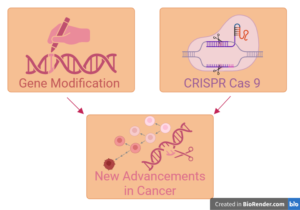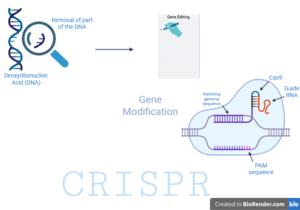
We all have wanted to change something about ourselves, such as our hair color. While this change isn’t permanent, there is something out there that could potentially make permanent changes inside the womb. Gene modification has made huge advancements recently, although the main focus isn’t on changes to a person’s appearance. Rather, it helps a person with diseases that are deemed fatal or simply affect the patient’s quality of life. With the advancements of CRISPR, which overall is a modifier, we could see these changes in the future whether these changes are physical or genetic.
Genes are small parts of DNA that can be found in all cells. Every gene has instructions called a code, which tells the cell how to make different proteins, each protein has a specific task. Within the human body, all of these cells have the same genes, but when it comes down to each cell individually, they only use the genes they need. This results in the cell activating the genes that it needs at the exact time by turning them on, and then the ones it does not need are turned off. This process is known as gene expression. The process of turning on some genes and turning off others is how we get specialized cells like red blood cells or muscle cells.
Every gene has instructions within them called a code. That code inside of every gene is held inside chemicals called nucleotides. There are 4 nucleotides that make up DNA: adenosine (A), thymine (T), guanine (G), and cytosine (C). Each cell is made up of this long chain of these nucleotides, and the order of the code tells the cell how it is supposed to make the specific protein. But, some people may have changes in the nucleotides (coding) of a gene, known as a mutation. For example, there can be one letter missing from the instructions. There are some gene mutations that could be good, some that have no impact, and some that are bad. One of the biggest impacts that these bad gene mutations could have is if the gene mutation starts to spread throughout the body, which is what causes cancer. Some of these genetic mutations could be inherited from a parent. Other mutations, known as acquired gene mutations, are not inherited from a parent, but instead develop at some point during a person’s lifetime. These mutations happen in one cell and then get passed on to new cells that come from that cell. Acquired gene mutations are a common cause of cancer compared to mutations that are inherited.

Scientists have found that changes in DNA can cause cancer. As a result, they have also been researching methods for manipulating the DNA in order to correct the coding of these nucleotides. In 2013, scientists showed that CRISPR was able to change the DNA of human cells. This form of technology has opened doors within the research of finding new treatments for cancer. CRISPR has improved cancer studies as a couple of studies have gone from using lab dishes to having clinical trials with patients who are diagnosed with cancer. In 2019, there was a trial launched by the University of Pennsylvania that was testing how CRISPR would work in cancer therapy. This marked the first trial in the United States to use CRISPR in cancer research. While there have been debates on the social and ethical aspects of gene modification in humans, the scientists at the core of using CRISPR when approaching cancer have been cautiously looking into what it can and cannot do, as well as practicing using this tool.
Clustered regularly interspaced short palindromic repeats, commonly known as CRISPR, is an adaptive immune system found in bacteria and archaea. Its evolution came with the acquisition of genetic material invaders, which would then form the protein that guides the modified DNA or RNA to target and in some cases neutralize foreign DNA or RNA by changing the existence of the expression or the expression itself. This is one of the main arrays used in order to precisely target a specific stand to be used for gene modification.
There have been many exciting recent advances between cancer and gene modification. Cancer is always seen as something scary and often seen as the enemy. Meaning that if there are new advancements to stop this enemy, then we should support those advancements. Approximately 38.9% of men and women will be diagnosed with cancer at one point in their life. We are not yet talking about finding a cure for cancer with CRISPR, but this technology holds promise, and we should consider investments in this work to better patient outcomes.
Written by: Helen Diego Jimenez and Dulce Aguilar Cruz
Edited by: Raeanne Lanphier and Elizabeth Abrash